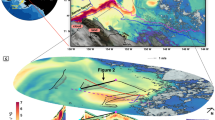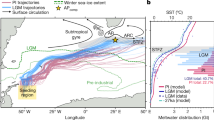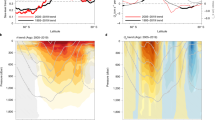Abstract
The overflow and descent of cold, dense water from the sills of the Denmark Strait and the Faroe–Shetland channel into the North Atlantic Ocean is the principal means of ventilating the deep oceans, and is therefore a key element of the global thermohaline circulation. Most computer simulations of the ocean system in a climate with increasing atmospheric greenhouse-gas concentrations predict a weakening thermohaline circulation in the North Atlantic as the subpolar seas become fresher and warmer1,2,3, and it is assumed that this signal will be transferred to the deep ocean by the two overflows. From observations it has not been possible to detect whether the ocean's overturning circulation is changing, but recent evidence suggests that the transport over the sills may be slackening4. Here we show, through the analysis of long hydrographic records, that the system of overflow and entrainment that ventilates the deep Atlantic has steadily changed over the past four decades. We find that these changes have already led to sustained and widespread freshening of the deep ocean.
This is a preview of subscription content, access via your institution
Access options
Subscribe to this journal
Receive 51 print issues and online access
$199.00 per year
only $3.90 per issue
Buy this article
- Purchase on Springer Link
- Instant access to full article PDF
Prices may be subject to local taxes which are calculated during checkout



Similar content being viewed by others
References
Rahmstorf, S. & Ganopolski, A. Long-term global warming scenarios computed with an efficient coupled climate model. Clim. Change 43, 353–367 (1999)
Delworth, T. L. & Dixon, K. W. Implications of the recent trend in the Arctic/North Atlantic Oscillation for the North Atlantic thermohaline circulation. J. Clim. 13, 3721–3727 (2000)
IPCC Climate Change 2001: The Scientific Basis (eds Houghton, J. T. et al.) (Cambridge Univ. Press, Cambridge, 2001)
Hansen, B., Turrell, W. R. & Østerhus, S. Decreasing overflow from the Nordic seas into the Atlantic Ocean through the Faroe-Shetland Channel since 1950. Nature 411, 927–930 (2001)
Curry, R. & McCartney, M. S. Ocean gyre circulation changes associated with the North Atlantic Oscillation. J. Phys. Oceanogr. 31, 3374–3400 (2001)
Lazier, J. R. N. in Natural Climate Variability on Decade-to-Century Time Scales (eds Martinson, D. G. et al.) 295–304 (National Academy Press, Washington DC, 1995)
Verduin, J. & Quadfasel, D. in European Sub-Polar Ocean Programme II, Final Scientific Report (ed. Jansen, E.) A1, 1–11 (Univ. Bergen, Bergen, 1999)
Lascaratos, A., Roether, W., Nittis, K. & Klein, B. Recent changes in deep water formation and spreading in the eastern Mediterranean Sea. Prog. Oceanogr. 44, 5–36 (1999)
Gordon, A. Weddell Deep Water variability. J. Mar. Res. 40, 199–217 (1982)
Hurrell, J. W. Decadal trends in the North Atlantic Oscillation: regional temperatures and precipitation. Science 269, 676–679 (1995)
Dickson, R. R., Lazier, J., Meincke, J., Rhines, P. & Swift, J. Long-term co-ordinated changes in the convective activity of the North Atlantic. Prog. Oceanogr. 38, 241–295 (1996)
Hurrell, J. W. & Dickson, R. R. in Ecological Effects of Climate Variations in the North Atlantic (eds Stenseth, N. C., Ottersen, G., Hurrell, J. W. & Belgrano, A.) (Oxford Univ. Press, in the press)
Sy, A. et al. Surprisingly rapid spreading of newly formed intermediate waters across the North Atlantic Ocean. Nature 386, 675–679 (1997)
Brewer, P. G. et al. A climatic freshening of the deep Atlantic north of 50°N over the past 20 years. Science 222, 1237–1239 (1983)
Swift, J. H. Climate Processes and Climate Sensitivity (eds Hansen, J. E. & Takehashi, T.) 39–47 (AGU Geophysical Monograph 29, American Geophysical Union, Washington DC, 1984)
Vinje, T., Nordlund, N. & Kvambekk, A. Monitoring ice thickness in Fram Strait. J. Geophys. Res. 103, 10437–10449 (1998)
Vinje, T. Fram Strait ice fluxes and atmospheric circulation, 1950-2000. J. Clim. 14, 3508–3517 (2001)
Dickson, R. R. et al. The Arctic Ocean response to the North Atlantic Oscillation. J. Clim. 13, 2671–2696 (2000)
Blindheim, J. et al. Upper layer cooling and freshening in the Norwegian Sea in relation to atmospheric forcing. Deep-Sea Res. I 47, 655–680 (2000)
Turrell, W. R., Slesser, G., Adams, R. D., Payne, R. & Gillibrand, P. A. Decadal variability in the composition of Faroe-Shetland Channel bottom water. Deep-Sea Res. I 46, 1–25 (1999)
Dickson, R. R. & Brown, J. The production of North Atlantic Deep Water: Sources, rates and pathways. J. Geophys. Res. C 99, 12319–12341 (1994)
Hansen, B. & Østerhus, S. North Atlantic–Nordic seas exchanges. Prog. Oceanogr. 45, 109–208 (2000)
Girton, J. B., Sanford, T. B. & Käse, R. H. Synoptic sections of the Denmark Strait Overflow. Geophys. Res. Lett. 28, 1619–1622 (2001)
Thompson, D. W. J., Wallace, J. M. & Hegerl, G. C. Annular modes in the extratropical circulation Part II: Trends. J. Clim. 13, 1018–1036 (2000)
Acknowledgements
We thank S.-A. Malmberg and H. Valdimarsson for the use of unpublished hydro-data from the Icelandic Standard Sections Programme, and A. Clarke and J. Lazier, whose efforts provided much of the Labrador Sea data that we use here. This work was part of the data synthesis phase of the WOCE Program, of the VEINS Project of the MAST III Programme of the European Community, and of the NOAA Consortium on the Ocean's Role in Climate of Scripps Institution of Oceanography, San Diego and Lamont-Doherty Earth Observatory, Palisades, New York; it was supported in part by the Office of Polar Programs and Geosciences Directorate of the NSF.
Author information
Authors and Affiliations
Corresponding author
Ethics declarations
Competing interests
The authors declare that they have no competing financial interests
Rights and permissions
About this article
Cite this article
Dickson, B., Yashayaev, I., Meincke, J. et al. Rapid freshening of the deep North Atlantic Ocean over the past four decades. Nature 416, 832–837 (2002). https://doi.org/10.1038/416832a
Received:
Accepted:
Issue Date:
DOI: https://doi.org/10.1038/416832a
This article is cited by
-
Hydrological cycle amplification reshapes warming-driven oxygen loss in the Atlantic Ocean
Nature Climate Change (2024)
-
Strain-specific transcriptional responses overshadow salinity effects in a marine diatom sampled along the Baltic Sea salinity cline
The ISME Journal (2022)
-
Long-term changes in the Arabian Peninsula rainfall and their relationship with the ENSO signals in the tropical Indo-Pacific
Climate Dynamics (2022)
-
Rapid freshening of Japan Sea Intermediate Water in the 2010s
Journal of Oceanography (2021)
-
Multi-decadal changes in the South China Sea mixed layer salinity
Climate Dynamics (2021)
Comments
By submitting a comment you agree to abide by our Terms and Community Guidelines. If you find something abusive or that does not comply with our terms or guidelines please flag it as inappropriate.



